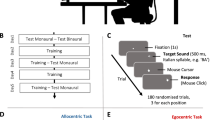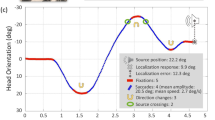Abstract
Because the inner ear is not organized spatially, sound localization relies on the neural processing of implicit acoustic cues. To determine a sound's position, the brain must learn and calibrate these cues, using accurate spatial feedback from other sensorimotor systems. Experimental evidence for such a system has been demonstrated in barn owls, but not in humans. Here, we demonstrate the existence of ongoing spatial calibration in the adult human auditory system. The spectral elevation cues of human subjects were disrupted by modifying their outer ears (pinnae) with molds. Although localization of sound elevation was dramatically degraded immediately after the modification, accurate performance was steadily reacquired. Interestingly, learning the new spectral cues did not interfere with the neural representation of the original cues, as subjects could localize sounds with both normal and modified pinnae.
This is a preview of subscription content, access via your institution
Access options
Subscribe to this journal
Receive 12 print issues and online access
$209.00 per year
only $17.42 per issue
Buy this article
- Purchase on Springer Link
- Instant access to full article PDF
Prices may be subject to local taxes which are calculated during checkout



Similar content being viewed by others
References
Middlebrooks, J. C. Narrow-band sound localization related to external ear acoustics. J. Acoust. Soc. Am. 61, 2607–2624 (1992).
Zakarouskas, P. & Cynader, M. S. A computational theory of spectral cue localization. J. Acoust. Soc. Am. 94, 1323–1331 (1993).
Oldfield, S. R. & Parker, S. P. Acuity of sound localization: a topography of auditory space. I. Normal hearing conditions. Perception 13, 581–600 (1994).
Frens, M. A. & Van Opstal, A. J. A quantitative study of auditory-evoked saccadic eye movements in two dimensions. Exp. Brain Res. 107, 103–117 (1995).
Knudsen, E. I. & Konishi, M. Mechanism of sound localization in the barn owl (Tyto alba). J. Comp. Physiol. A 133, 13–21 (1979).
Batteau, D. W. The role of pinna in human localization. Proc. R. Soc. Lond. B 168, 158–180 (1967).
Blauert, J. Spatial Hearing. The Psychophysics of Human Sound Localization. (MIT Press, Cambridge, Massachusetts, 1996).
Teranishi, R. & Shaw, E. A. G. External-ear acoustic models with simple geometry. J. Acoust. Soc. Am. 44, 257–263 (1968).
Lopez-Poveda, E. A. & Meddis, R. A physical model of sound diffraction and reflections in the human concha. J. Acoust. Soc. Am. 100, 3248–3259 (1996).
Wightman, F. L. & Kistler, D. J. Headphone simulation of free-field listening. I. Stimulus synthesis. J. Acoust. Soc. Am. 85, 858–867 (1989).
Oldfield, S. R. & Parker, S. P. Acuity of sound localization: a topography of auditory space. II. Pinna cues absent. Perception 13, 601–617 (1984).
Wenzel, E. M., Arruda, M., Kistler, D. J. & Wightman, F. L. Localization using nonindividualized head-related transfer functions. J. Acoust. Soc. Am. 94, 111–123 (1993).
Hofman, P. M. & Van Opstal, A. J. Spectro-temporal factors in two-dimensional human sound localization. J. Acoust. Soc. Am. 103, 2634–2648 (1998).
Knudsen, E. I. & Knudsen, P. F. Vision guides the adjustment of auditory localization in young barn owls. Science 230, 545–548 (1985).
Knudsen, E. I. & Knudsen, P. F. Vision calibrates sound localization in developing barn owl. J. Neurosci. 9, 3306–3313 (1989).
Knudsen, E. I. & Mogdans, J. Vision-independent adjustment of unit tuning to sound localization cues in response to monaural occlusion in developing owl optic tectum. J. Neurosci. 12, 3485–3493 (1992).
Brainard, M. S. & Knudsen, E. I. Experience-dependent plasticity in the inferior colliculus: a site for visual calibration of the neural representation of auditory space in the barn owl. J. Neurosci. 13, 4590–4608 (1993).
King, A. J., Hutchings, M. E., Moore, D. R. & Blakemore, C. Developmental plasticity in the visual and auditory representation in the mammalian superior colliculus. Nature 332, 73–76 (1988).
Withington-Wray D. J., Binns, K. E. & Keating, M. J. The maturation of the superior collicular map of auditory space in the guinea pig is disrupted by developmental visual deprivation. Eur. J. Neurosci. 2, 682–692 (1990).
Javer, A. R. & Schwarz, D. W. F. Plasticity in human directional hearing. J. Otolaryngol. 24, 111–117 (1995).
Knudsen, E. I., Esterly, S. D. & Olsen, J. F. Adaptive plasticity of the auditory space map in the optic tectum of adult and baby barn owls in response to external ear modification. J. Neurophysiol. 71, 79–94 (1994).
Knudsen, E. I. & Knudsen, P. F. The sensitive period for auditory localization in barn owls is limited by age, not by experience. J. Neurosci. 6, 1918–1924 (1986).
King, A. J. & Moore, D. R. Plasticity of auditory maps in the brain. Trends Neurosci. 14, 31–37 (1991).
Knudsen, E. I. Capacity for plasticity in the adult owl auditory system expanded by juvenile experience. Science 279, 1531–1533 (1998).
Stein, B. E. & Meredith, A. M. The Merging of the Senses (MIT Press, Cambridge, Massachusetts, 1993).
Perrett, S. & Noble, W. The contribution of head motion cues to localization of low pass-noise. Percept. Psychophys. 59, 1018–1026 (1997).
Schröder, M. R. Synthesis of low-peak factor signals and binary sequences with low autocorrelation. IEEE Trans. Inform. Theory 16, 85–89 (1970).
Robinson, D. A. A method of measuring eye movement using a scleral search coil in a magnetic field. IEEE Trans. Biomed. Eng. 10, 137–145 (1963).
Collewijn, H., Van der Mark, F. & Janssen, T. J. Precise recording of human eye movements. Vision Res. 15, 447–450 (1975).
Press, W. H., Flannery, B. P., Teukolsky, S. A. & Vettering, W. T. Numerical Recipes in C, 2nd edn (Cambridge Univ. Press, Cambridge, 1992).
Efron, B. & Tibshirani, R. Statistical analysis in the computer age. Science Wash. D.C. 253, 390–395 (1991).
Acknowledgements
This research was supported by the Dutch Foundation for the Life Sciences (SLW 805-33.705-P; PMH), the University of Nijmegen, the Netherlands (AJVO), and the Human Frontiers Science Program (RG0174/1998-B; AJVO).
Author information
Authors and Affiliations
Corresponding author
Rights and permissions
About this article
Cite this article
Hofman, P., Van Riswick, J. & Van Opstal, A. Relearning sound localization with new ears. Nat Neurosci 1, 417–421 (1998). https://doi.org/10.1038/1633
Received:
Accepted:
Issue Date:
DOI: https://doi.org/10.1038/1633
This article is cited by
-
Effective sound detection system in commercial car vehicles using Msp430 launchpad development
Multimedia Tools and Applications (2023)
-
Memristor-based analogue computing for brain-inspired sound localization with in situ training
Nature Communications (2022)
-
Adaptive learning and recall of motor-sensory sequences in adult echolocating bats
BMC Biology (2021)
-
Evaluating hearing performance with cochlear implants within the same patient using daily randomization and imaging-based fitting - The ELEPHANT study
Trials (2020)



